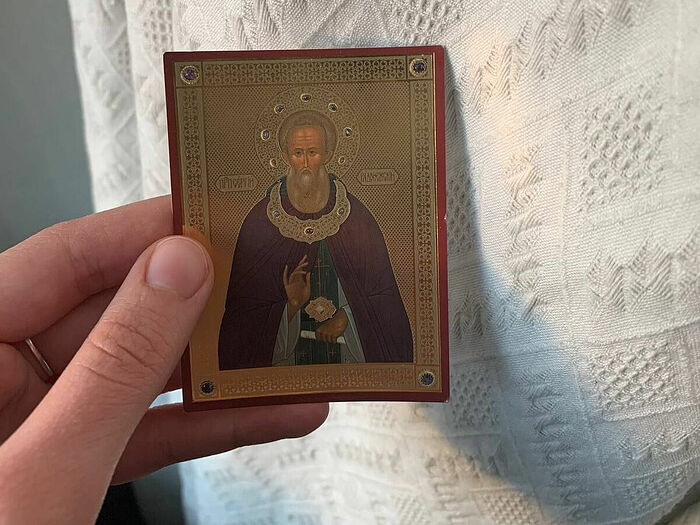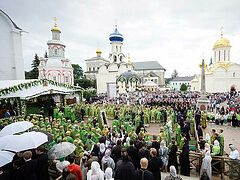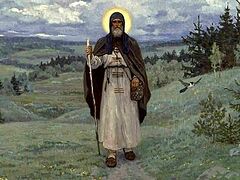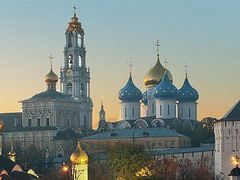Once in January, in the late 1990s, I was conducting a group of pilgrims who had come to celebrate the Nativity of Christ in the Holy Land. The trip program was remarkable, the Russian pilgrims were given quarters in the guesthouse of the Gornensky Convent in Jerusalem, and on the day of the feast all set out for the night service in Bethlehem. Visits to holy places of Galilee were planned for the guests at the end of the pilgrimage.
There, in Cana of Galilee, where during His earthly service Jesus Christ worked the first of His miracles by turning the water into wine, we visited a Greek Orthodox church. Because this new church was built on the site of the old one in the 1880s, using funds from the [Russian] Imperial Orthodox Palestinian Society, icons were installed in the deacons’ doors of the iconostasis of St. Sergius of Radonezh and Righteous Elizabeth—the heavenly patrons of Grand Prince Sergei Alexandrovich and his wife, Holy Martyr Grand Princess Elizabeth Feodorovna. After the restoration work done in the 1990s, abbot of the monastery Theophilos (Yannopoulos), who is now the Patriarch of Jerusalem, moved these icons to the gallery of the monastery’s inner court.
Seeing an icon of St. Sergius of Radonezh in the iconostasis of the church, I venerated it, as is the accepted practice in the Greek tradition. At that time I was dealing with certain problems in life, and I needed to make a fatal decision. As it goes, I as usual had no time for special prayers. And now, as I approached the icon, I surprisingly to myself pronounced question: “Tell me, Fr. Sergius, should I turn to you in prayer with this matter, will you help me in the Holy Land—or would it be better for me to pray to St. Savva the Sanctified who was such a great saint here, like you were in Russia?” Naturally I didn’t expect an answer. The thoughts that had been hidden deep in my subconscious just broke out.
But I soon received an answer! And in a simply amazing way.
After visiting Cana, the pilgrims I was conducting went straight to the Jordan. After all, it has from ancient times been considered one of the most important events in a Christian pilgrimage in the Holy Land to immerse yourself in the sacred waters of that river.
Bethabara, the place where the Savior was baptized, was still inaccessible at the time. Only a rare pilgrim was able to visit it, and only once a year, on the Eve of Theophany.
And so, the whole group (and there were forty of us) rode a bus to Yardenit—a site organized for immersion, not far from the place with the Jordan flows from the lake of Galilee. We encountered a crowd of pilgrims from all over the world, and so we decided to go a little off to the side, to another, wild and unequipped but deserted place, so that we could reverently and peacefully perform the rite of immersion in the waters of the sacred river.
When the priest had finished the rite of sanctifying the waters and the pilgrims had changed into their white robes, they began to enter the waters while I stepped off to the side. After a little while I noticed that one of my group members was standing there completely dressed. This surprised me, because usually all the guests of the Holy Land gladly immerse themselves in the Jordan. At my inquiry as to why she doesn’t go into the water, the woman replied that it’s now winter and rather cold, and she herself lives in Israel—she joined the group because her close friend had come from Moscow. She decided that she would come another time, in the summer, to immerse herself in the Jordan. We started talking. As it turns out, her name is Zoya; she was a repatriate from Russia and for several years now she had been living in Israel in a state of emotional disturbance, in a serious depression, often suffering attacks from the dark powers both in dreams and while awake. From her cautious tale it seemed to me that occult practices preceded this bitter state.
Practicing false mysticism and direct communication with the world of spirits does not go by without leaving a trace. The day came when a false “angel of light” revealed its true colors (cf. 2 Cor. 11:14), and its demonic essence began to intrude itself into the everyday life of this unfortunate woman with frightening force. During these difficult days of emotional suffering and inconsolable grief, she turned in prayer and deep feelings of repentance to Jesus Christ as the true God. The great sorrows that had been allowed to come upon her by God’s Providence led her to the knowledge of the truth, to solid and unwavering faith that other than the name of Jesus Christ there is none other name under heaven given among men, whereby we must be saved (Acts 4:12). You can call this a return to the faith, since Zoya had been baptized in Russia when she was already an adult, albeit not entirely consciously, without the proper preparation. In a word, she had not been catechized.
After this prayer, a ray of light poured into her sad soul compassed by melancholy and darkness, and the joy of life returned. She came to believe in the love and mercy of God, but her trials were not yet over. The peace that had come to reign in her soul turned out to be temporary. She would soon to have a cruel struggle with the spirits of evil. She needed wise counsel about how to go on living. At that time, Zoya didn’t yet know that in Haifa, where she lived, there is a Russian Orthodox Church.
We stood by the banks of the Jordan under the arching eucalyptus branches, the sun peering at us through the clouds, and the wind flicking the tips of the majestic date palms. The woman continued her touching, and as it turned out, providential story.
When she learned that in Jerusalem there is the Gornensky Monastery, where Russian nuns live, she wrote a letter there briefly relating her state and asking for advice. A little while later a letter came from the mother superior, Abbess Georgia, who explained to her that in a demonic struggle strong prayer is needed. The abbess also sent in the letter to her several paper icons and three akathists—to Archangel Michael, St. Sergius and Radonezh, and St. Seraphim of Sarov.
Great is the power of prayer! In the words of St. Theophan the Recluse, it is a mighty spiritual weapon: Put on the whole armour of God, that ye may be able to stand against the wiles of the devil (Eph. 6:11). Hope and the joy of life returned to the woman who had up till then been living on the verge of total despair. In Zoya’s words, the akathists became the “rope that pulled my soul out of hell.” The Akathist gave the woman so worn down by struggles with the demons a source for the complete renewal of her emotional powers. During her reading of the prayers, which she did both day and night, God’s help was so tangible that her soul was literally born again. Peace, hope, and joy took up their abode in her, but the greatest strengthening of her faith was an event that occurred right on the feast of the Nativity of Christ.
Our schedule, as I mentioned earlier, was very tight. After the night service in Bethlehem they broke the fast in the monastery trapeza, had a brief rest, and then visited holy places till late in the evening. When they returned in the evening to Gornensky Convent, tired but happy, Zoya and her friend talked for a long time. In need simply of some human sympathy, Zoya told her friend about how she had found faith, and about the unbelievable sorrows and demonic attacks. And then through these recollections her former feelings of despair and helplessness returned to her soul with terrible force, leading her literally to the abyss, beyond which is emptiness and the depths of hell.
It was after midnight when the two friends laid down to sleep. Zoya could not fall asleep for a long time; she just lay there on the bed, wiping her tears. In those difficult moments, when the soul is filled to the brim with memories of former sorrows, in the completely dark room she suddenly saw a bright light and the extraordinarily joyful, loving, and encouraging iconic face of a saint. However, she was unable to recognize him. In those days there was no internet where you could easily find icons of any saints. Zoya only knew that it was without a doubt either St. Sergius of Radonezh or St. Seraphim of Sarov. After all, the abbess of Gornensky Convent had sent her small paper icons in a letter, she had read akathists to these great Russian saints every day, and they had protected her like an invisible shield from the terrible onslaught of the powers of darkness.
This miraculous appearance of St. Sergius on the great feast of the Nativity of Christ, when we glorify the incarnation on earth of the Son of God, served to greatly strengthen her faith. Peace and calm reigned once again in her soul, and hope shone that the Lord with His strong arm would not abandon her on the true path.
The next day, on January 8, the second day of the feast, all the pilgrims were present at Divine Liturgy in the Kazan Church at Gornensky Convent. Zoya came together with all the others. Her heart rejoiced and trembled from the absolutely real feeling of God’s presence in her life. A feeling of sacred joy filled her soul, but the thought never left her: Who was it that appeared to her during the night? St. Seraphim of Sarov, or St. Sergius of Radonezh? And at one moment she looked off to the side and saw that joyful, bright face on the icon. It was St. Sergius! It’s impossible to describe with words the feelings of that moment. Zoya wept, but not from sadness. These were tears of compunction and the joy of a heart that had come to know the true God…
After she had told her story, we stood a long time in silence on the banks of the Jordan, where the sky was reflected in the dark green waters. Suddenly I remembered how I had approached the icon of St. Sergius with my question in Cana of Galilee… This was the second miracle of St. Sergius of Radonezh. My conversation with the pilgrimess was no accident. St. Sergius is powerful to help people, even in the Holy Land!




